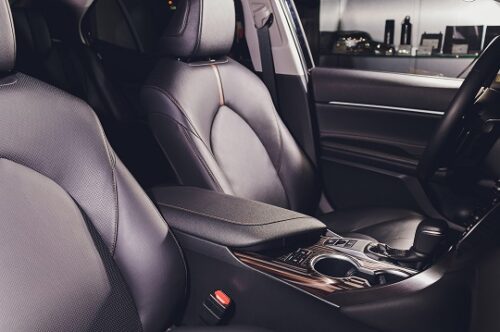6 January 2023
An article in Auto Express gives a handy overview of the different interior options major car manufacturers are currently offering. What is most interesting is that the vast majority of manufacturers surveyed continue to offer leather either as standard or as an option. It’s easy to get the impression that leather is being ‘cancelled’ across the board, but this is very far from the truth. It remains the number one choice for many – and with good reason. What’s more, as tanneries across Europe are making stringent efforts to minimise the environmental impact of leather making, some manufacturers are going even further by championing the use of leather tanned with natural olive-leaf extract – normally a waste product. Ironically, this is in contrast to the plethora of synthetic interior materials being offered which – despite their ‘green’ image – are invariably questionable in terms of sustainability. Report by One 4Leather.

Vegan alternatives for leather
According to the article, the ‘vegan’ options being offered fall into three main categories:
1. Generic so-called ‘synthetic/artificial leather’ products such as Ultrasuede, microfibre, vinyl or textiles.
2. Materials using recycled plastic (e.g. PET bottles)
3. Brand new proprietary materials (e.g. Alcantara as used by Bentley and Ferrari among others)
1. Generic ‘imitation leather’ products
Some companies use synthetic leather substitutes such as the microfiber material called Ultrasuede. Typically microfibre materials contain man-made plastics including polyester and polyurethane which will not degrade at the end of their useful life making them a potential cause of long-term environmental pollution. Various manufacturers offer such polyurethane-based ‘vegan leather’ but, as we have mentioned before, being vegan-friendly does not automatically mean being environmentally-friendly.
2. Materials using recycled plastic
Other manufacturers are taking a different approach to material choice. The options they offer include materials that feature recycled plastic such as ‘Sequal’ which is based on re-using plastic waste from the oceans. Another route is to use recycled polyethersulfone (PES) to make interiors, while Race-Tex is advertised as “a high-quality microfibre material partially consisting of recycled polyester fibres.” Last but not least, there’s Econyl fabric which is based on recycled nylon.
Without a doubt it is good to recycle plastic as a way of preventing it from polluting the environment – and it makes a great ‘green’ story for a brand to tell. But ultimately, plastic is plastic, and the question remains: What happens to these materials at the end of their useful life? Being incorporated into a composite product they are likely to be very difficult to extract and isolate when the material is thrown away and so could end up in the environment (e.g. landfill or as incinerated waste) after all.
3. Brand new proprietary materials
‘Alcantara’ is described by Fashion Network as “the first fully sustainable ‘Made in Italy’ brand” and it is used by some prestigious car makers. According to the Alcantara website, “Alcantara S.p.A. pays extreme attention to utilize recycled polyester produced in Europe by post consumers scraps, recycled through a mechanical process, being traceable and certificated”, and it has an extensive programme to “reduce greenhouse gas emissions, offsetting residual emissions through certified and verified offsetting projects”. As mentioned above, recycling plastic is good up to a point, but at some stage it is still likely to end up back in the environment.
Dinamica microsuede is a similar material option. But Forbes Magazine reports that Alcantara recently won a court case against the company, accusing it of ‘greenwashing’. It is perhaps a reminder that we should take all claims about sustainability in car interior materials with a pinch of salt.
Other proprietary materials include Sensico which is described as a “synthetic non-animal based premium upholstery”. According to bmwexpert.net, Sensatec is “a vinyl-based type of leather… made from materials like polyvinyl chloride (PVC), polyurethane (PU), or polyester microfibers”. Grain is added to make it more natural leather looking but it’s unlikely to meet all of the performance characteristics of leather.
One 4 Leather is happy to be quoted at the end of the article which reminds readers that “no animal is killed for your car seat”, and that leather is simply a great (and sustainable) way to use a waste product from the meat industry. As a natural product, it is completely biodegradable and far more sustainable in terms of a cradle to grave analysis than almost all the other options being offered by car manufacturers. At the end of the day, however, we encourage people to come to their own conclusions and to make their own decisions about their car interior, and articles like this are vital to give everyone the facts they need.
我们为皮革、物料及时装业界创造面对面洽谈的机会,为客户缔造实质商机。我们云集世界各地的商家,让他们寻找新的合作伙伴,发掘潜在客户或供应商,并掌握业界最新发展。
我们主办多个专注时尚及生活潮流的商贸展览会, 为这不断变化的行业,提供最全面的买家及参展商服务,方便他们了解急速转变的行业环境,并预测来季趋势。

使用条款 | 隐私政策 | APLF 可持续发展